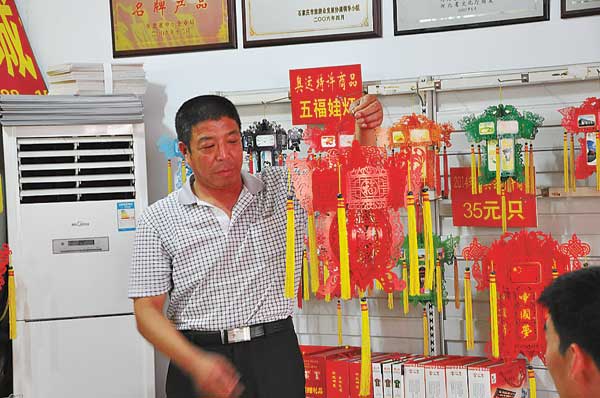 |
|
Zhang Fengjun, intangible cultural heritage inheritor of palace lantern-making, shows off a lantern made in his factory.
|
Patenting intangible heritage walks a fine line, China Art Institute researcher and doctoral supervisor Yuan Li says.
"Intangible cultural heritage is regional, which means it belongs to many people in a specific area," he says.
"Patents are exclusive. That runs against tradition and intangible cultural heritage's essence."
Other countries have been tackling this question for more than two decades with no clear solution, he points out.
The Indian government has gone to the mat over yoga patents awarded to US companies. It says "yoga theft" runs counter to the soul of the spiritual practice that's a part of shared traditional knowledge. India's government won the nullification of the multinational Metaproteomics' patent on ancient turmeric-based medicines Indian families use as folk remedies.
Two months ago, Good Morning to You Productions Corp sued Time Warner Inc's Warner/Chappell Music to demand a refund of the $1,500 licensing fee it paid the copyright holder of Happy Birthday to You - listed in the Guinness Book of World Records as the most recognized English-language song - arguing the traditional tune should be in the public domain.
Yuan says it's a blurry line between traditional craftsmanship and heritage forms' extrinsic features inherited by many people - which should never be patented - and innovative designs based on tradition. But patent offices lack mechanisms to measure the distinctions, he says.
An image database and recognition system would be an effective solution. India created one with 1,500 yoga poses to send to patent offices.
China Folk Culture Association deputy director Liu Delong believes patents could protect some crafts.
"However, some patents are too general," he says.
There have been lawsuits surrounding the name "Shandong brocade", for instance. The heritage form has no specific style, pattern or material.
Palace lanterns' IPRs haven't generated legal disputes.
Whatever their impact, business is booming. And the tradition is being continued.
Tuntou's industry is also bringing the Chinese intangible heritage form into international consciousness.
Zhang's company produced the lanterns that shone upon the Beijing Olympics and Shanghai World Expo.
They're exported to Australia, Russia, Southeast Asia and the Middle East.
And they dangle in Beijing's Zhongnanhai and the Great Hall of the People.
The village also produces customized moving lanterns - some are simple robots - of various shapes. Dragons twist, fish swim and birds fly in Gaocheng Palace Lanterns' display room. Fifty-six pairs of lanterns are shaped like couples from the country's ethnic groups.
Laser printers etch lanterns in the rooms surrounding a courtyard of vegetables in one section of the compound.
Su, the village head who runs another company, says Tuntou's palace lantern industry has illuminated opportunities for locals and offers a bright future.
"I used to make car parts," he says.
"Business was bad. So I started this. And business is brilliant."
Zhang Zixuan contributed to the story.
We recommend:
